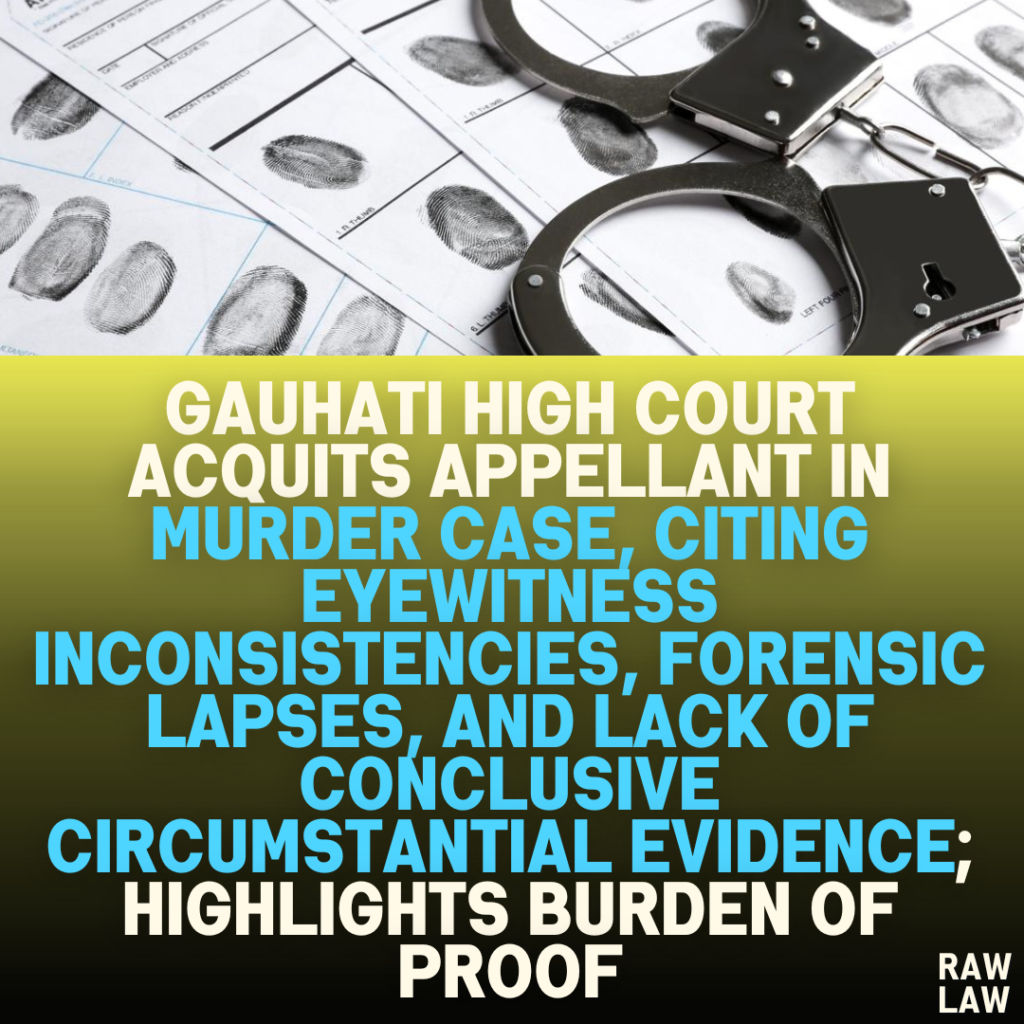Court’s Decision:
The Gauhati High Court reversed the conviction of the appellant under Section 302 of the Indian Penal Code (IPC), as the prosecution failed to provide sufficient conclusive evidence to establish guilt beyond a reasonable doubt. The court found that the evidence primarily rested on circumstantial elements, and the appellant’s alleged flight from the scene alone was not enough to substantiate the conviction.
Facts:
The case involved an incident where the deceased was found dead near a tea factory after an alleged altercation. An eyewitness claimed to have seen the appellant pushing the deceased into the water, but other witnesses, including the deceased’s brother, only heard calls for help without witnessing any physical altercation. A dao (sharp weapon) and other items were found near the site but lacked forensic testing to establish a clear link to the appellant. The medical report suggested death by a head injury rather than drowning, conflicting with the eyewitness account.
Issues:
The primary issue was whether the circumstantial evidence and the eyewitness testimony provided a sufficient basis for convicting the appellant of murder.
Petitioner’s Arguments:
The appellant contended that the case was based solely on circumstantial evidence, challenging the reliability of the eyewitness’s testimony due to inconsistencies and the absence of direct evidence of the crime. The defense argued that circumstantial evidence should provide a complete chain pointing to the appellant’s guilt, which was lacking in this case.
Respondent’s Arguments:
The prosecution argued that the appellant was seen fleeing from the scene, which, coupled with the eyewitness testimony, constituted sufficient evidence. They further claimed that under Section 106 of the Indian Evidence Act, the appellant was obliged to explain his presence at the crime scene.
Analysis of the Law:
The court examined the principles of circumstantial evidence, emphasizing the need for a complete chain of evidence to support a conviction in cases lacking direct evidence. The court cited previous rulings stating that guilt must be established without any reasonable hypothesis of innocence.
Precedent Analysis:
The judgment referenced the Supreme Court’s decision in Sharad Birdhichand Sarda v. State of Maharashtra, outlining standards for circumstantial evidence, and the decision in Rambraksh v. State of Chhattisgarh, which clarifies the limitations of the “last seen together” theory. It also cited Balvir Singh v. State of Uttarakhand regarding the appropriate application of Section 106 of the Evidence Act, noting that the prosecution must first fulfill its evidentiary burden before this section can apply.
Court’s Reasoning:
The court observed inconsistencies in the eyewitness testimony, noting it did not align with the medical evidence. The court highlighted that while the appellant’s behavior (running from the scene) raised suspicion, it did not independently substantiate guilt. Furthermore, forensic lapses, such as the failure to test the dao for bloodstains, weakened the prosecution’s case. The court also reasoned that, per the standards in Sharad Birdhichand Sarda, the prosecution’s evidence was insufficient to exclude all reasonable hypotheses other than guilt.
Conclusion:
The court concluded that the evidence presented did not meet the required standard for conviction in a murder case. The court, thus, set aside the conviction and ordered the release of the appellant, granting the benefit of doubt.
Implications:
This ruling reinforces the principle that mere suspicion or partial circumstantial evidence cannot justify a conviction. The decision underscores the necessity of corroborative evidence in cases relying on circumstantial facts and clarifies the appropriate application of Section 106 of the Evidence Act, reaffirming that the prosecution bears the full burden of establishing guilt before shifting any evidentiary expectations onto the accused.




Pingback: "Bombay High Court Sets Aside Eviction Decree, Directs Heirs to File Fresh Suit to Independently Establish Bonafide Need Following Plaintiff’s Death" - Raw Law